
OSU Blue Fruit tomato. Not yet commercially available (to my knowledge), this is a breeding line of purple-black tomatoes developed at Oregon State University in the US. The fruits ripen to a deep coal black but are perhaps at their most beautiful during the ripening phase when they take on some magnificent purple tones. The flavour is decent enough, although work is still being done to improve it. And no, they are not genetically modified: the colour was achieved through traditional breeding methods by combining three genes found in South American wild tomatoes.
I have been rather quiet on the blogging front haven't I? The reason is that I'm now working full time for a small publishing company, and also writing a book about potato breeding which will be available in late summer or early September. The book will answer all your questions about growing from TPS and potato seed saving, and to the best of my knowledge will be the first book of its kind on the subject. It's all very exciting and enjoyable, but as you can imagine I am immensely and obscenely busy, and working some very long hours.
Today however, I'm closeted indoors as it's the first warm and sunny weekend of the year and that inevitably means the neighbours are having a barbecue. There's nothing like the stench of burning flesh to send me scuttling back into the house with all the windows shut; so here I am, and may as well do something useful like posting some of the tomato pictures I took last year and didn't get round to using for anything. All of these were grown in the greenhouse unless otherwise stated.
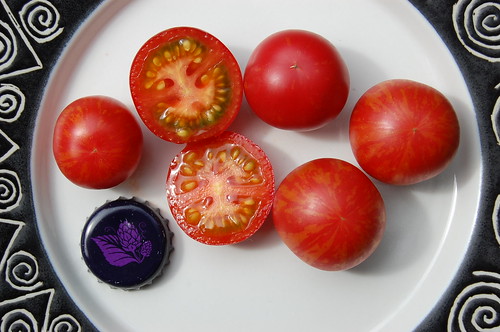
Darby Striped Pink/Yellow. This came from the Heritage Seed Library and is an absolute corker. It's actually an English-bred tomato, from the breeding work of Lewis Darby at the Glasshouse Crops Research Institute in Littlehampton in the 1950s and 60s. Dr Darby also produced the well-known striped variety Tigerella (a variety which I've seen described around the internet as a poor performer, which has not been my experience of it at all - it would seem that it grows better in the UK than in the US, which has led many American gardeners to be disappointed with it). Anyway, this Pink/Yellow line was never released as a commercial variety, which is a shame, because it is fantastic. The flavour is exquisitely rich and fruity, the texture is just right, the yields are very generous and the rounded fruits are a lovely deep pink-red with yellow stripes ripening to orange. It's definitely one I will grow again, and it has such a lot going for it.

Tangella. Another of Dr Lewis Darby's creations, this bright orange tomato was released commercially and enjoyed some popularity in its day, but was subsequently deleted from the National List and is now rare. Once again, it was the Heritage Seed Library which supplied me with seeds. I don't rate the flavour of this one as highly as the Pink/Yellow variety above; it's milder and mellower, although it does have a tang to it. It is very firm on the outside but has a very soft texture in the flesh, bordering on the mushy when fully ripe. But it is a nice variety, and the colour is absolutely gorgeous ... a vibrant deep orange all the way through and probably high in carotenes. The fruits come out at a variety of sizes and are a rounded apple-shape, and being bred in England, it is very happy with the UK climate.
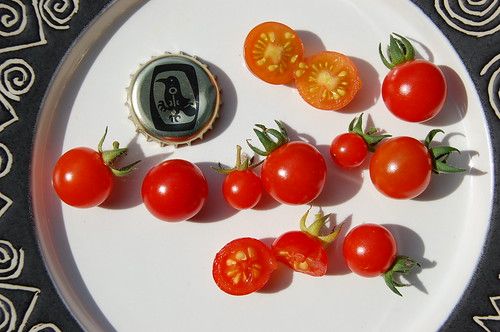
Tomatito de Jalapa. Another one I'd recommend. This tiddly tiny cherry tomato was given to me by Patrick Wiebe at Bifurcated Carrots, but previously came from Frank Van Keirsbilck in Belgium. The thing that makes it special is that it's supposed to have blight resistance. Others who have tried it have had mixed results, some finding it blight-resistant and others not, with an additional observation that it needs to be deprived of any kind of feed or fertiliser in order to work its anti-fungal magic. My own experience was that it was blight tolerant rather than blight resistant as such. I grew it outdoors with full exposure to the elements, and gave it no fertiliser or special treatment. I also grew a normal non-resistant variety beside it as a 'control' ... not very scientific, but it gave me something to compare it with. Tomatito de Jalapa held off the blight better than the control plant did, and succumbed at a much slower rate, and although it did become infestans-infested, what was interesting was that the blight didn't get into the fruits, even when the stems they were growing on became blighted. Thus the plant was stricken with blight but I was still able to go on harvesting the fruits for some while - unlike the control plant, whose fruits rapidly became inedible. So this is definitely one to try if you want to grow outdoor tomatoes and be fairly confident of getting a crop. Having said that, the blight was a bit later in 2010 than it has been in previous years, so it remains to be seen how it will cope in a "bad" blight season. However, there's more to a variety than disease resistance, and Tomatito de Jalapa has a lot to recommend it. The small fruits are absolutely delicious - sharp and fruity - and borne on long trusses which ripen beautifully in the English outdoors. Productivity certainly didn't suffer much for the lack of fertiliser. So although the tomatoes are tiny, you get a constant supply over a long period, and overall yield is high. I'll certainly grow it again.
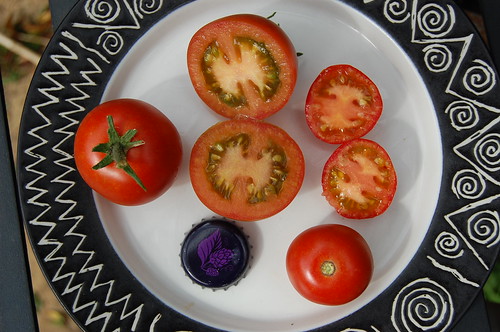
Essex Wonder. Popular in the 1930s as a market garden variety developed especially for the glasshouse industry in Essex, this is another "deleted" variety rescued from near extinction by the Heritage Seed Library. This crop was grown outdoors, which wasn't really ideal for it, but it coped. I've had better results growing it in a greenhouse in the past. It's a classic tomatoey tomato; in other words it's almost perfectly spherical, bright red, and has a nice old-fashioned tomato flavour. The size varies considerably, as does the thickness of the flesh, and the gel around the seeds is distinctly green.
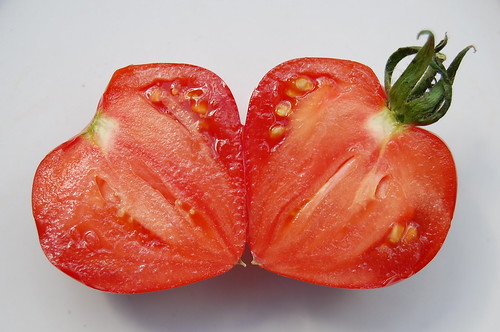
Anna Russian. An oxheart-type tomato. Oxhearts tend to be large, strawberry shaped and immensely fleshy, with few seeds. They also tend to be a bit on the bland side, and that's where Anna Russian is a glorious exception, being very rich and flavoursome. The fruits are a deep dark rosy pink with a mildly ribbed surface, and bright red inside. As they're so fleshy (and tasty) they work extremely well in slices and would probably be good in sandwiches. Yields are pretty respectable - higher than you'd think from the rather floppy plants - and early maturing. Despite the name I believe this variety comes from the US, though it may well have been taken there by Russian immigrants. My seeds came from Association Kokopelli in France. Sorry there's no bottle-top for scale in this picture, but the fruits are of quite variable size.
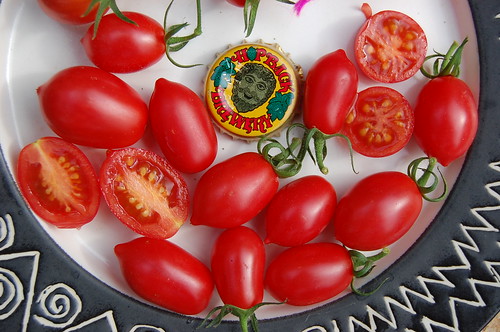
Pink Freud F4. One of my own little projects which I'm quite pleased with. Now in an F4, it produces masses of miniature shiny silky Roma-plum tomatoes on large trusses, dark pink before ripening to deep red. The flavour is fabulous, and they are equally good raw or stewed up into a luxurious sauce. They also have incredible keeping properties, and ripe fruits can be left in the kitchen (unrefrigerated) for weeks on end with no loss of quality. I've no idea who its parents were, it arose from saving and selecting seed from a punnet of F1 hybrid tomatoes I bought in Marks and Spencer's in 2002. A great example of why you should ignore the received wisdom that saving seeds from F1 hybrids is a waste of time. On the contrary, "doesn't come true from seed" is another way of saying "has lots of exciting diversity". So if you grow any F1 hybrid tomatoes, either from seed packets or supermarkets, do try saving their seeds and see what surprising and delightful goodies they throw up for you.

Pugliese Green. Perhaps this should be re-christened Pugliese Red. I was given the seeds by Jeremy Cherfas of Agricultural Biodiversity, who is living in Italy and bought the fruits at a local shop. They are thought to be a locally-developed variety from the Puglia region of Italy (the heel of the boot). I grew them in 2009, allowed them to ripen to a full vibrant red, and was absolutely knocked out by how good they tasted. Really one of the best-flavoured tomatoes I've ever tasted. But when I blogged about it last time, Jeremy informed me that this isn't how they are eaten in Italy. As I should have guessed from the fact that he called them Pugliese Green, they are supposed to be eaten while they're still a bit green. So this year I tried it. And yes, they are indeed very tasty while green-ish. But I still maintain that the really knockout flavour develops when they are fully ripe! It's also remarkable how rapidly they ripen. One minute they're sitting there with no more than a blush of red, and the next day when you go to check them they are bright as a post-box. The fruits are medium sized, firm to the touch, and take the form of slightly flattened globes. The photo shows a couple of fruits in the intermediate semi-green stage as well as the full red. Take your pick. The fact remains that this is a very fine tomato, whatever colour it is when you eat it. Thanks Jeremy.
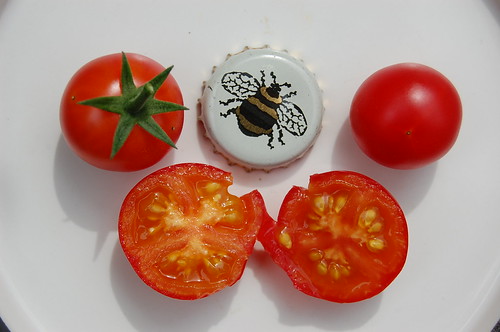
Isis Candy. Popular in the US but pretty much unknown over here (I bought the seeds a few years ago from an American seed company), this is a little treasure, and actually originated in Eastern Europe. It's a small tomato, but not small enough to call a cherry; it's very rounded and elegantly symmetrical, globe-shaped but distinctly flattened. It's thin-skinned and very juicy, and has a really lovely sharp tangy flavour. It's also very beautiful, passing through many shades of orange, pink and red, sometimes in marbled combination. A regular favourite.

Green Zebra. A green-when-ripe stripey tomato bred by Tom Wagner in the US and released in the 1980s through his TaterMater seed company. It can now be found in catalogues worldwide, and is widely grown and well loved. Fruits are a decent size and exquisitely striped, with more of a mottled pattern underneath. People often ask how you know when it's ripe, and the answer is that the lighter stripes change to a golden colour, which is quite distinctive when you see it. You can also give the fruits a little squeeze if in doubt. It does taste slightly different from a red tomato, and has quite a sharp, acidic tang.
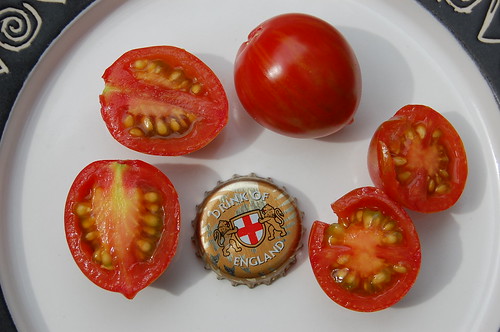
Banana Legs x Green Tiger F1. Another of my own breeding projects, this time from a cross I made between one of Tom Wagner's creations, Banana Legs, and a Marks & Spencer's commercial variety, Green Tiger (not to be confused with Green Zebra above). Banana Legs is a light yellow elongated tomato with silvery stripes and a distinct nipple on the end, while Green Tiger is a perfectly spherical, smooth and shiny tomato with deep burgundy red flesh and dark olive-green stripes over its red skin. What I find fascinating about this F1 hybrid is that it's in almost every way an exact intermediary between the two parent types. It's got silvery-green stripes (not very clear in this photo as they stand out more when unripe), and the shape is an extended globe with a small nipple. This half-way blend fascinates me because it's not something that happens in my pea-breeding projects. With peas, the dominant genes assert themselves completely in the F1 hybrid, with recessive traits completely hidden until they start segregating out of the F2. I'm not a tomato breeder, I only have an occasional casual dabble, so it intrigues me to see how differently the genes express themselves in tomatoes. It's results like this which illustrate why it took so many thousands of years for humans to understand the processes of genetic inheritance, assuming wrongly that it was a simple "blending" process, and it also perhaps shows why it was with peas that the great breakthrough of understanding was made. Anyway, I could go on about how beautiful and high yielding this hybrid was, and that the flavour was pretty decent - but it doesn't really matter what traits it has, because I cannot preserve it in this form. Every seed is an F2 with a different genetic shake-up, so presumably when I sow them I will start getting segregation for the various parental traits rather than this half-way mix. But we shall see.
Something else interesting about my 2010 tomato crop which I will only talk about briefly as I need to do some more experimentation before I conclude anything. I took the slightly strange decision not to feed any of my tomato plants, but just to grow them au naturel, as it were. The inspiration for this was an incident in the 2009 season when I became so busy I had to abandon some tomato plants in the greenhouse - only to find months later that they were fruiting beautifully despite having no water or fertiliser, and also in immaculate blight-free health, even though blight was rampaging through the garden outside. This experience set me thinking, and then when Patrick gave me the Tomatito de Jalapa seeds with the instruction not to feed the plants as their blight-resistance only works if they aren't fed, something went ker-chinggg in my head.
So in 2010 I grew my greenhouse tomatoes without any fertiliser whatsoever, and I only watered them when they were really desperate. The results really astonished me. The plants didn't grow anywhere near as big as they would do with a "normal" feeding and watering routine, and so I suppose they produced fewer fruits too, but in terms of the number of fruits which were edible ... the yields were the highest I've ever had. This is because all the fruits were perfect - immaculate, healthy and blemish free. I had no blossom-end rot, I had no splitting (except very late in the season), I had no mouldering and squishing, and most remarkably I HAD NO BLIGHT. There was plenty of blight outside, it killed all the potatoes and the outdoor tomatoes. But the greenhouse tomatoes had none at all. It may be that they were just lucky, or sufficiently sheltered, but I don't think so ... I think they were so happy and healthy they managed to fight off all nasties. It's as if the lack of feeding enabled them to fulfil their natural potential instead of being forcibly plumped up into oversized bloaters. Another possibly significant factor: because the plants only grew to about 6ft and didn't sprawl like triffids all the way up to the ceiling and out the roof, it wasn't necessary to do much pruning at all. I just nipped out a couple of sidebuds when the plants were young and then left them to it. I'm wondering if the non-pruning also helped to keep them healthy, because this is exactly what the great Dominique Guillet asserts in his book The Seeds of Kokopelli. He reckons pruning is nothing short of tomato-abuse, and believes very firmly that the lack of pruning in his tomato crops is what keeps them blight-free.
Lots of food for thought and further experimentation here. If anyone else has any experience with growing tomatoes without fertiliser, or is perhaps brave enough to experiment with it in 2011, I'd love to hear about it.